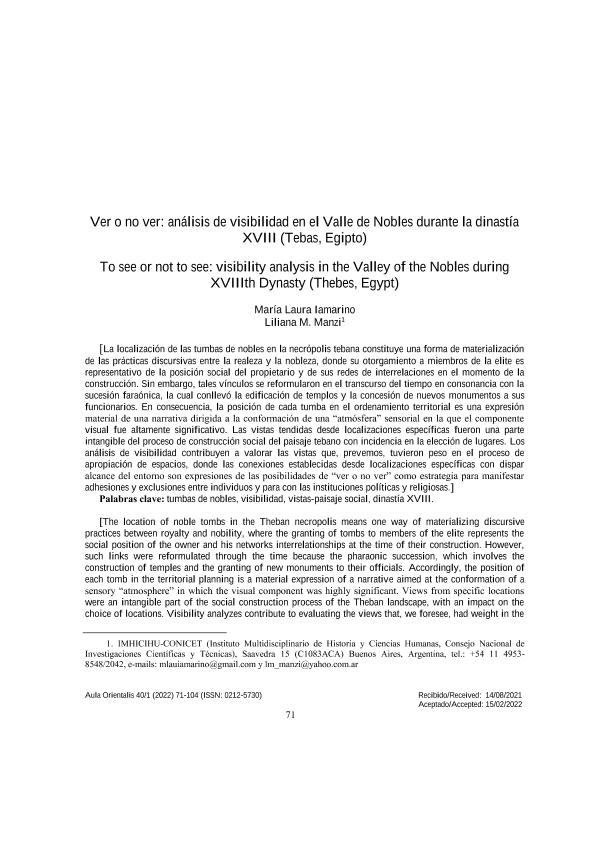Artículo
La localización de las tumbas de nobles en la necrópolis tebana constituye una forma de materialización de las prácticas discursivas entre la realeza y la nobleza, donde su otorgamiento a miembros de la elite es representativo de la posición social del propietario y de sus redes de interrelaciones en el momento de la construcción. Sin embargo, tales vínculos se reformularon en el transcurso del tiempo en consonancia con la sucesión faraónica, la cual conllevó la edificación de templos y la concesión de nuevos monumentos a sus funcionarios. En consecuencia, la posición de cada tumba en el ordenamiento territorial es una expresión material de una narrativa dirigida a la conformación de una “atmósfera” sensorial en la que el componente visual fue altamente significativo. Las vistas tendidas desde localizaciones específicas fueron una parte intangible del proceso de construcción social del paisaje tebano con incidencia en la elección de lugares. Los análisis de visibilidad contribuyen a valorar las vistas que, prevemos, tuvieron peso en el proceso de apropiación de espacios, donde las conexiones establecidas desde localizaciones específicas con dispar alcance del entorno son expresiones de las posibilidades de “ver o no ver” como estrategia para manifestar adhesiones y exclusiones entre individuos y para con las instituciones políticas y religiosas. The location of noble tombs in the Theban necropolis means one way of materializing discursive practices between royalty and nobility, where the granting of tombs to members of the elite represents the social position of the owner and his networks interrelationships at the time of their construction. However, such links were reformulated through the time because the pharaonic succession, which involves the construction of temples and the granting of new monuments to their officials. Accordingly, the position of each tomb in the territorial planning is a material expression of a narrative aimed at the conformation of a sensory “atmosphere” in which the visual component was highly significant. Views from specific locations were an intangible part of the social construction process of the Theban landscape, with an impact on the choice of locations. Visibility analyzes contribute to evaluating the views that, we foresee, had weight in the process of appropriation of spaces, where the connections established from specific locations with disparate scope of the environment are expressions of the possibilities of “to see or not to see” as a strategy to manifest adhesions and exclusions between individuals and towards political and religious institutions.
Ver o no ver: Análisis de visibilidad en el Valle de Nobles durante la dinastía XVIII (Tebas, Egipto)
Título:
To see or not to see: Visibility analysis in the Valley of the Nobles during XVIIIth Dynasty (Thebes, Egypt)
Fecha de publicación:
05/2022
Editorial:
Ausa
Revista:
Aula Orientalis
ISSN:
0212-5730
Idioma:
Español
Tipo de recurso:
Artículo publicado
Clasificación temática:
Resumen
Palabras clave:
Tumbas de nobles
,
Vistas y visibilidad
,
Paisaje social
,
Dinastía XVIII
Archivos asociados
Licencia
Identificadores
Colecciones
Articulos(IMHICIHU)
Articulos de INST.MULTIDISCIP.DE HISTORIA Y CS.HUMANAS
Articulos de INST.MULTIDISCIP.DE HISTORIA Y CS.HUMANAS
Citación
Iamarino, Maria Laura; Manzi, Liliana Mabel; Ver o no ver: Análisis de visibilidad en el Valle de Nobles durante la dinastía XVIII (Tebas, Egipto); Ausa; Aula Orientalis; 40; 1; 5-2022; 71-104
Compartir




